
Infection Control Market: Growth, Size, Share, and Trends
Infection Control Market by Product (Sterilization Equipment: Hydrogen Peroxide, Ethylene, Radiation), Service (ETO, Gamma, E-Beam), Disinfection (Wipes, Disinfector), Gown, Mask, Endoscope Reprocessing, End User (Hospital, Pharma) - Global Forecast to 2030




OVERVIEW
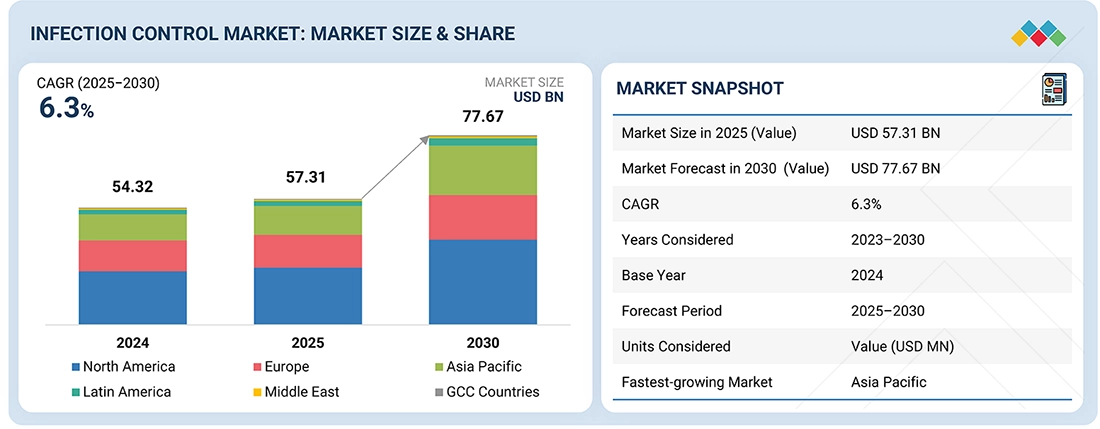
Source: Secondary Research, Interviews with Experts, MarketsandMarkets Analysis
The global infection control market is projected to reach USD 77.67 billion by 2030 from USD 57.31 billion in 2025, at a CAGR of 6.3% during the forecast period. The growth of the infection control market is driven by the rising prevalence of healthcare-associated infections (HAIs), the increasing number of surgical procedures, and continuous advancements in reprocessing technologies. There is also a growing emphasis on sterilization and disinfection of food, along with technological improvements in sterilization equipment and an increasing trend of outsourcing services among pharmaceutical companies, medical device manufacturers, and hospitals. However, the market faces restraints such as growing concerns about the safety of reprocessed instruments, the consequences associated with chemical disinfectant use, and the high cost of endoscopy reprocessing, coupled with limited reimbursements. Simultaneously, opportunities lie in the increasing prevalence of medical device and pharmaceutical companies in developing nations, the reintegration of ethylene oxide sterilization, and the growing utilization of E-beam sterilization. Key challenges include the sterilization of advanced medical devices, the emergence of alternative methods for surface disinfection, and the increasing adoption of single-use medical devices, which may reduce the need for traditional reprocessing methods.
KEY TAKEAWAYS
-
BY PRODUCT & SERVICEThe products & services segment of the infection control market encompasses a wide range of solutions designed to prevent and control infections across healthcare, food, and pharmaceutical settings. Key product categories include sterilization and disinfection equipment, chemical disinfectants, consumables, and endoscope reprocessing. In addition, the services segment covers instrument reprocessing, sterilization outsourcing, and facility hygiene management, which are increasingly adopted by hospitals, diagnostic laboratories, and pharmaceutical companies to ensure compliance with stringent infection control standards. The integration of innovative technologies, such as automated sterilizers, E-beam sterilization, and surface disinfectants, is enhancing the efficiency and effectiveness of these products and services. Growing awareness of infection prevention, regulatory compliance requirements, and the rising demand for safe healthcare practices continue to drive expansion in this segment, offering significant opportunities for providers of both products and specialized services.
-
BY END USERThe end user segment of the infection control market plays a crucial role in driving demand, as organizations increasingly prioritize infection prevention and safety. Growth in this segment is fueled by rising awareness of hygiene standards, stricter regulatory requirements, and the need to minimize the risk of infections across various settings. End users are increasingly adopting infection control solutions to improve operational safety, ensure compliance, and enhance overall results, making this segment a major driver of the market’s growth.
-
BY REGIONThe global infection control market is divided into North America, Europe, Asia Pacific, Latin America, the Middle East & Africa, and GCC Countries. Asia Pacific is witnessing strong growth due to its rising HAI prevalence and inceasing number of surgeries.
-
COMPETITIVE LANDSCAPEThe global infection control market is steadily growing, driven by strategic partnerships and strong R&D investments. Key players like STERIS (US), Reckitt Benckiser Group plc. (UK), Fortive (US), Sotera Health (US), Solventum (US) and others leverage diverse product portfolios and innovation to expand globally through collaborations, acquisitions, and new product launches.
The infection control market is experiencing growth driven by several critical factors, including the rising incidence of healthcare-associated infections (HAIs), an increasing number of surgical procedures, and ongoing advancements in reprocessing technologies. Additional drivers include heightened focus on food sterilization and disinfection, improvements in sterilization equipment technology, and a growing trend among pharmaceutical companies, medical device manufacturers, and hospitals to outsource services. Despite this growth, the market faces challenges, including concerns over the safety of reprocessed instruments, risks associated with chemical disinfectants, and the high costs of endoscopy reprocessing, which are compounded by limited reimbursements. Meanwhile, opportunities are emerging from the expansion of medical device and pharmaceutical sectors in developing countries, the renewed application of ethylene oxide sterilization, and increased adoption of E-beam sterilization. Key hurdles include effectively sterilizing advanced medical devices, the rise of alternative surface disinfection methods, and the growing use of single-use medical devices, which may reduce reliance on conventional reprocessing techniques.
TRENDS & DISRUPTIONS IMPACTING CUSTOMERS' CUSTOMERS
The impact on the infection control market is closely tied to shifts in customer demand and treatment practices. Hospitals, clinics, and other end users are the primary end users of infection control product manufacturers. Changes in treatment protocols, adoption of advanced products, or disruptions in infection control delivery directly influence demand from end users. This, in turn, affects the procurement decisions of healthcare facilities, ultimately impacting the revenues of infection control product manufacturers.
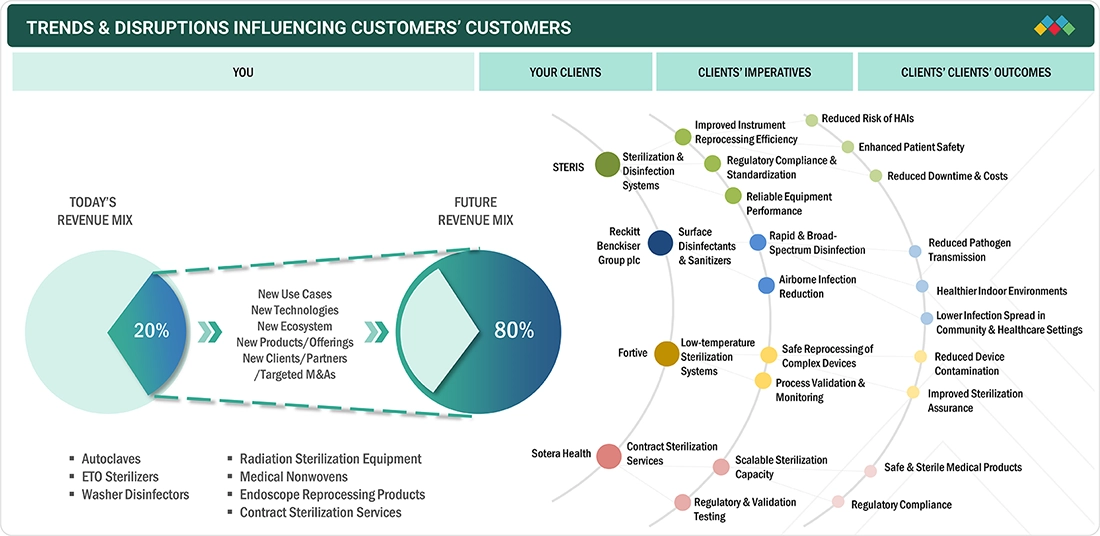
Source: Secondary Research, Interviews with Experts, MarketsandMarkets Analysis
MARKET DYNAMICS
Level
-
Rising prevalence of HAIs

-
Increasing number of surgical procedures
Level
-
Growing concerns about safety of reprocessed instruments
-
Consequences associated with chemical disinfectant use
Level
-
Increasing prevalence of medical devices and pharmaceutical companies in developing nations economies
-
Reintegration of ethylene oxide sterilization
Level
-
Sterilization of advanced medical devices
-
Alternative methods for surface disinfection
Source: Secondary Research, Interviews with Experts, MarketsandMarkets Analysis
Driver:Rising prevalence of HAIs
The rising prevalence of healthcare-associated infections (HAIs) is a major driver for the infection control market, as healthcare facilities seek effective measures to reduce infection rates and enhance patient safety. Increasing incidences of HAIs, driven by invasive procedures, antibiotic resistance, and prolonged hospital stays, have heightened the demand for advanced sterilization, disinfection, and hygiene solutions. This growing burden on healthcare systems underscores the critical need for robust infection control practices, prompting hospitals, laboratories, and other healthcare settings to adopt innovative products and services. As a result, the market continues to expand, driven by the urgent imperative to prevent infections and improve overall healthcare outcomes.
Restraint: Growing concerns about safety of reprocessed instruments
Growing concerns about the safety of reprocessed medical instruments pose a significant restraint on the infection control market. Reprocessing errors, incomplete sterilization, or improper handling of reusable instruments can lead to cross-contamination and healthcare-associated infections, raising doubts about their reliability. These safety concerns have prompted stricter regulatory guidelines and increased scrutiny from healthcare authorities, making healthcare providers cautious about relying heavily on reprocessed instruments. As a result, the perceived risks associated with instrument reprocessing can limit market growth and drive demand toward alternative solutions, such as single-use devices or more advanced sterilization technologies.
Opportunity: Increasing prevalence of medical devices and pharmaceutical companies in developing nations economies
The expanding presence of medical device manufacturers and pharmaceutical companies in developing economies presents a significant opportunity for the infection control market. As these regions witness rapid healthcare infrastructure growth and increased investment in medical technologies, the demand for effective infection prevention solutions rises correspondingly. Growing healthcare awareness, along with the need to comply with international quality and safety standards, drives adoption of sterilization, disinfection, and hygiene practices. This trend presents infection control providers with the opportunity to tap into emerging marthe kets, introduce innovative solutions, and support the safe expansion of healthcare services in developing nations.
Challenge: Sterilization of advanced medical devices
The sterilization of advanced medical devices presents a major challenge for the infection control market. Complex device designs, heat-sensitive materials, and intricate components make conventional sterilization methods less effective or potentially damaging. Ensuring complete microbial elimination without compromising device functionality requires specialized technologies and rigorous protocols, which can be costly and resource-intensive. This challenge is further compounded by the growing adoption of minimally invasive and implantable devices, increasing the need for precise, reliable, and validated sterilization processes. As a result, the complexity of sterilizing advanced medical devices remains a critical barrier to widespread and cost-effective infection control.
Infection Control Market: COMMERCIAL USE CASES ACROSS INDUSTRIES
| COMPANY | USE CASE DESCRIPTION | BENEFITS |
|---|---|---|
 |
Provides comprehensive infection prevention solutions including low-temperature sterilization systems, endoscope reprocessing technologies, and sterile processing software for healthcare facilities managing surgical instruments and endoscopy procedures | Enhances patient safety by minimizing hospital-acquired infections, ensures compliance with infection control guidelines, streamlines workflow efficiency, and supports real-time monitoring for reduced contamination risks and optimized reprocessing |
 |
Delivers hygiene and disinfection products such as disinfectant sprays, wipes, and sanitizers, for surface cleaning and air sanitization in healthcare settings, public spaces, and high-traffic areas | Kills 99.9% of viruses and bacteria, including those causing COVID-19 and flu, boosts customer confidence through science-backed protocols, reduces illness transmission, and provides comprehensive protection for staff, patients, and environments |
 |
Offers advanced sterilization and disinfection technologies including hydrogen peroxide systems, endoscope cleaners, and monitoring tools for sterilizing medical devices and preventing infections in hospitals and surgical centers | Pioneers low-temperature sterilization to protect heat-sensitive instruments, reduces hospital-acquired infections as a leading cause of morbidity, ensures sterility assurance with greater efficiency, and supports healthcare facilities in safeguarding patient outcomes |
 |
Supplies outsourced terminal sterilization services via gamma irradiation, ethylene oxide, electron beam, and X-ray modalities, along with lab testing for medical devices and pharmaceuticals | Delivers mission-critical end-to-end solutions to eliminate health threats, ensures reliable supply and validation for global healthcare needs, mitigates risks with expert advisory, and promotes safe, innovative sterilization for millions annually |
 |
Focuses on infection prevention in wound care with antimicrobial dressings, negative pressure wound therapy systems, and skin protectants for managing surgical sites, chronic wounds, and at-risk incisions | Controls bacterial growth and removes infectious materials to promote faster healing, reduces surgical site infections and readmissions, optimizes wound environments for granulation, and lowers overall care costs through evidence-based outcomes |
Logos and trademarks shown above are the property of their respective owners. Their use here is for informational and illustrative purposes only.
MARKET ECOSYSTEM
The infection control market ecosystem comprises a network of manufacturers, distributors, healthcare providers, and development partners working together to ensure effective infection control. Manufacturers drive innovation by developing sterilization equipment, disinfectant products, and other products. Distributors, logistics providers, and group purchasing organizations ensure the timely supply and availability of products across regional and global healthcare markets. Hospitals, clinics, and other healthcare facilities are the primary end users, adopting infection control products to improve patient comfort. Strategic partnerships, technological advancements, and increased investments are expanding access to infection control products, enabling wider adoption and enhancing the quality of care across diverse healthcare environments.
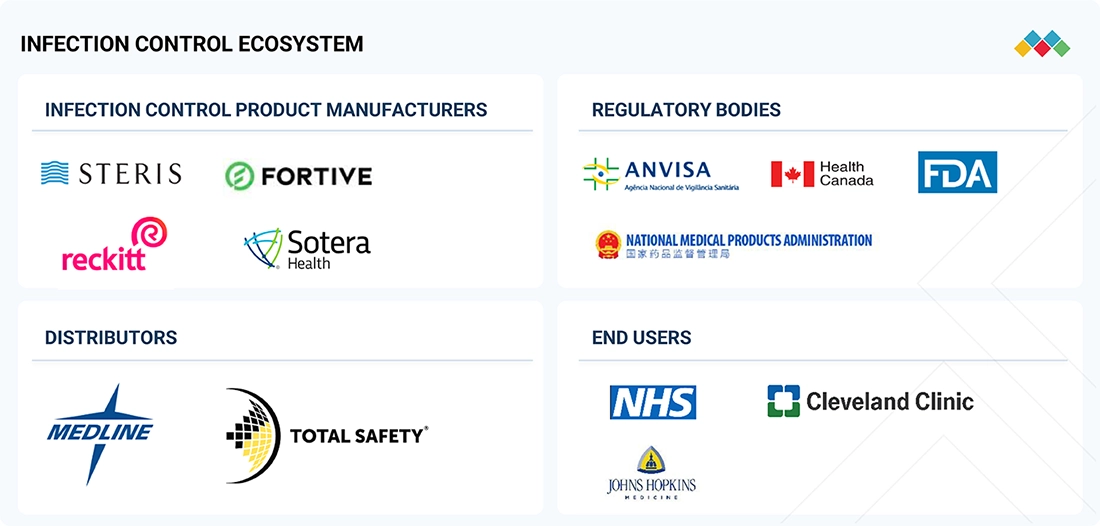
Logos and trademarks shown above are the property of their respective owners. Their use here is for informational and illustrative purposes only.
MARKET SEGMENTS
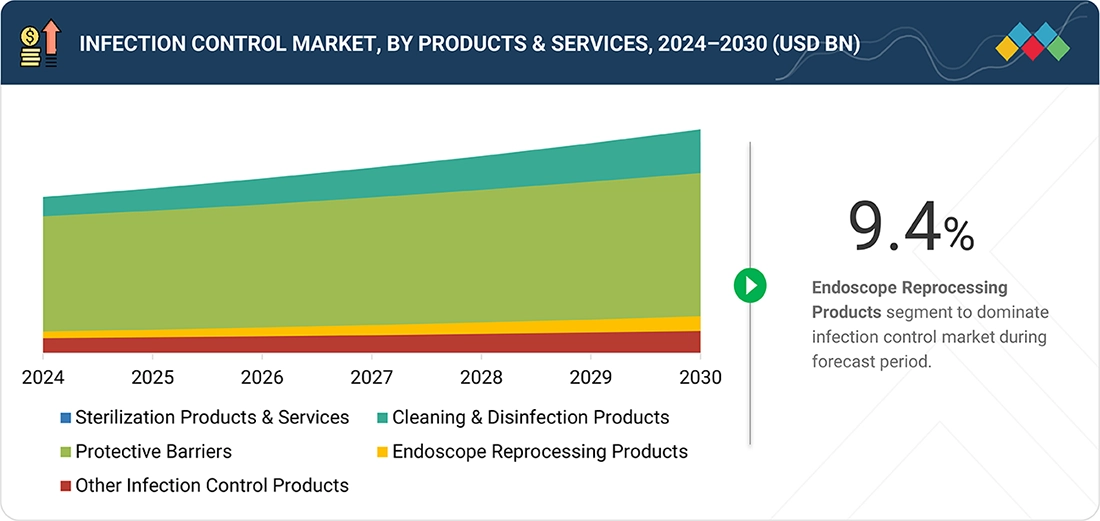
Source: Secondary Research, Interviews with Experts, MarketsandMarkets Analysis
Infection Control Market, By Products & Services
The infection control market is divided into five primary segments based on treatment: sterilization products & services, cleaning & disinfection products, protective barriers, endoscope reprocessing products, and other infection control products. Among these, cleaning & disinfection products serve as a cornerstone of infection control, playing a critical role in eliminating pathogens from surfaces, equipment, and environments to break the chain of infection. Widely used in hospitals, laboratories, pharmaceutical facilities, and public spaces, these products serve as the first line of defense against healthcare-associated infections, supporting regulatory compliance and ensuring patient safety. Their versatility, ease of use, and essential role in preventive and corrective infection control measures make them the most widely adopted category in the market.
Infection Control Market, By End User
Based on end users, the infection control market is divided into hospitals & clinics, medical device companies, pharmaceutical companies, the life science industry, the food industry, and other end users. Among these, hospitals & clinics accounted for the largest market share in 2024, as they face the highest risk of infection transmission due to high patient volumes, frequent invasive procedures, and extensive use of medical devices. The need for strict sterilization, disinfection, and hygiene protocols, along with regulatory compliance and accreditation requirements, drives continuous investment in infection control solutions. Their pivotal role in healthcare delivery positions hospitals and clinics as the primary end users in the market.
REGION
Asia Pacific is projected to be the fastest-growing market of the infection control market during the forecast period
The growth of the Asia Pacific infection control market is propelled by the rising prevalence of healthcare-associated infections (HAIs) and other factors. This growing health concern has increased the urgency for effective infection prevention and management strategies across the region. A surge in government initiatives plays a pivotal role, as governments implement stricter regulations and fund programs to enhance infection control practices in healthcare facilities. The expanding healthcare infrastructure, marked by the construction of new hospitals and clinics, along with upgrades to existing ones, further supports this growth by providing the necessary platforms for advanced infection control solutions. Additionally, there is a greater awareness of advanced infection control options among healthcare professionals and the public, fueled by educational campaigns and technological advancements, which encourages widespread adoption. Rising healthcare expenditure, driven by increasing patient volumes and economic development, also contributes significantly, enabling investments in cutting-edge sterilization, disinfection, and hygiene products. Together, these factors are accelerating the adoption of sophisticated infection control measures across hospitals, clinics, and home care settings, positioning the Asia Pacific as a dynamic and rapidly evolving market in this sector.
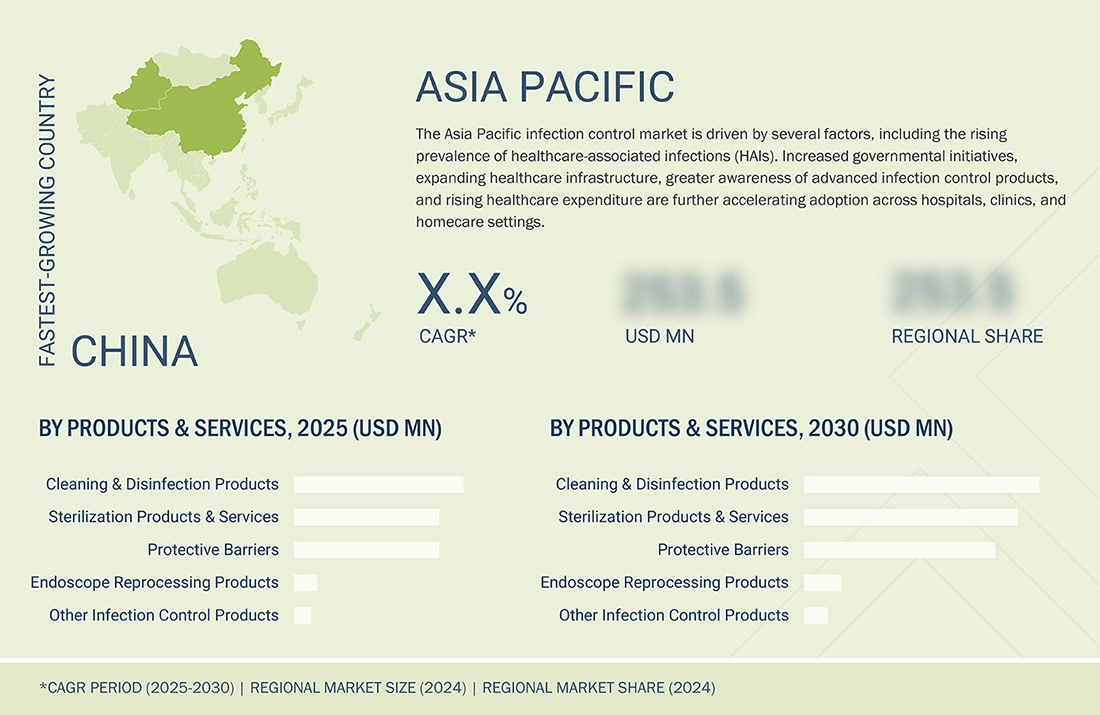
Infection Control Market: COMPANY EVALUATION MATRIX
STERIS (US) holds a prominent position in the infection control market due to its comprehensive portfolio of sterilization, disinfection, and infection prevention products and services. The company’s strong focus on innovation, high-quality standards, and adherence to stringent regulatory requirements has established it as a trusted provider for healthcare facilities, laboratories, and pharmaceutical companies worldwide. Additionally, STERIS benefits from a well-established global presence, robust customer relationships, and continuous investments in research and development, enabling it to offer advanced, reliable solutions that address evolving infection control needs and maintain its leadership in the market. Olympus Corporation (Japan) is one of the leading emerging players in the infection control market, leveraging its advanced endoscope reprocessing and sterilization solutions to enhance patient safety and healthcare hygiene standards.
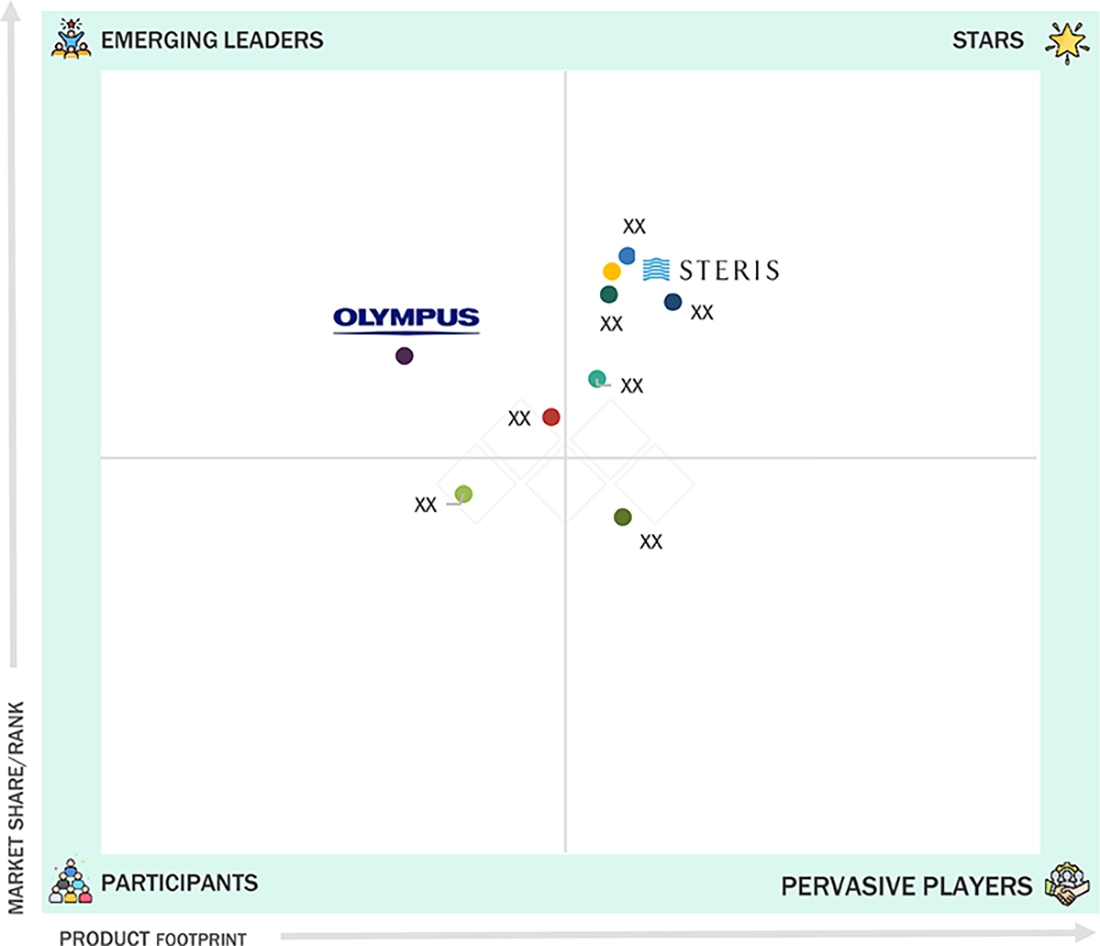
Source: Secondary Research, Interviews with Experts, MarketsandMarkets Analysis
KEY MARKET PLAYERS
MARKET SCOPE
| REPORT METRIC | DETAILS |
|---|---|
| Market Size Value in 2025 (Value) | USD 57.31 Billion |
| Market Forecast in 2030 (Value) | USD 77.67 Billion |
| Growth Rate | CAGR of 6.3% from 2025 to 2030 |
| Years Considered | 2023–2030 |
| Base Year | 2024 |
| Forecast Period | 2025–2030 |
| Units Considered | Value (USD Million) |
| Report Coverage | Revenue Forecast, Company Ranking, Competitive Landscape, Growth Factors, and Trends |
| Segments Covered |
|
| Regional Scope | North America, Europe, Asia Pacific, Latin America, Middle East & Africa, and GCC Countries |
WHAT IS IN IT FOR YOU: Infection Control Market REPORT CONTENT GUIDE
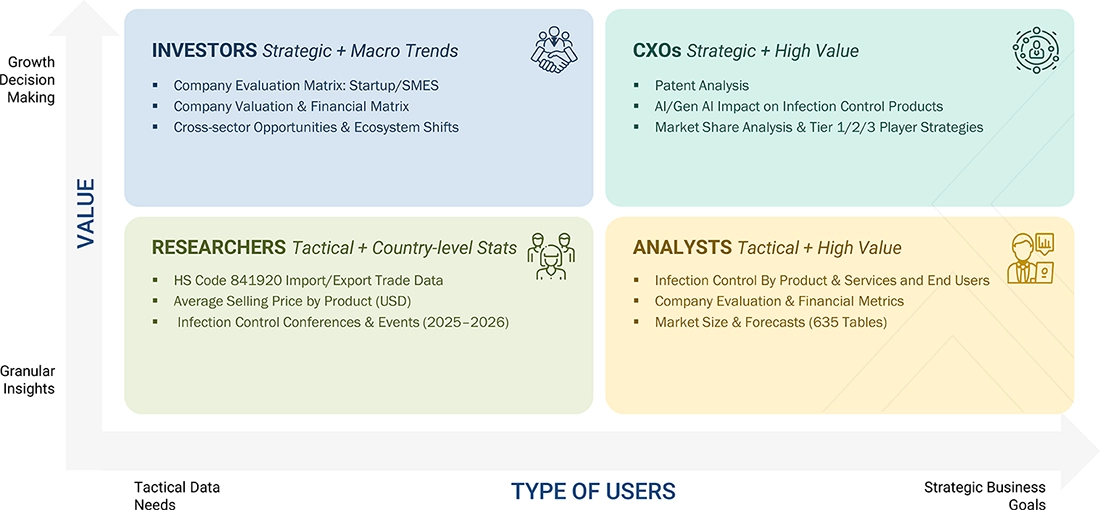
RECENT DEVELOPMENTS
- August 2023 : STERIS acquired the surgical instrumentation, laparoscopic instrumentation, and sterilization container assets from Becton, Dickinson and Company to strengthen, complement, and expand the product portfolio within its healthcare division.
- October 2023 : Getinge acquired Healthmark Industries Co., Inc., a US-based leading provider of innovative instrument care and infection control consumables. This strategic move strengthens Getinge's footprint in sterile reprocessing in the United States.
- April 2023 : Ecolab acquired Hazel Analytics, a technology-driven public health company. It now operates within the EcoSure division, further strengthening EcoSure’s capabilities to help clients mitigate brand risk and optimize guest experience and food safety.
- April 2024 : Solventum completed its spinoff from 3M and began trading independently on the New York Stock Exchange under the ticker symbol “SOLV.” The company advances healthcare solutions by integrating material and data science to improve patient outcomes and support healthcare professionals.
Table of Contents

- 5.1 INTRODUCTION
-
5.2 MARKET DYNAMICSDRIVERSRESTRAINTSOPPORTUNITIESCHALLENGES
- 5.3 TRENDS/DISRUPTION IMPACTING CUSTOMER BUSINESS
-
5.4 PRICING ANALYSISAVERAGE SELLING PRICE TREND OF STERILIZATION PRODUCTS, BY KEY PLAYERS, 2023-2025AVERAGE SELLING PRICE TREND, BY PRODUCTS, 2023-2025AVERAGE SELLING PRICE TREND BY REGION, 2023-2025
- 5.5 VALUE CHAIN ANALYSIS
- 5.6 SUPPLY CHAIN ANALYSIS
- 5.7 ECOSYSTEM ANALYSIS
- 5.8 INVESTMENT & FUNDING SCENARIO
-
5.9 TECHNOLOGY ANALYSISKEY TECHNOLOGIES- HEAT STERILIZATIONCOMPLEMENTARY TECHNOLOGIES- ULTRA-HIGH PRESSURE STERILIZATIONADJACENT TECHNOLOGIES- NITROGEN DIOXIDE (NO2)
- 5.10 PATENT ANALYSIS
-
5.11 TRADE ANALYSISIMPORT SENARIOEXPORT SCENARIO
- 5.12 KEY CONFERENCES & EVENTS, 2025-2026
- 5.13 CASE STUDY ANALYSIS ON INFECTION CONTROL MARKET
-
5.14 REGULATORY LANDSCAPEREGULATORY FRAMEWORKREGULATORY BODIES, GOVERNMENT AGENCIES AND OTHER ORGANIZATIONS
-
5.15 PORTER'S FIVE FORCE ANALYSISDEGREE OF COMPETITIONBARGAINING POWER OF SUPPLIERSBARGAINING POWER OF BUYERSTHREAT OF SUBSTITUTESTHREAT OF NEW ENTRANTS
-
5.16 KEY STAKEHOLDERS & BUYING CRITERIAKEY STAKEHOLDERS IN THE BUYING PROCESSBUYING CRITERIA
- 5.17 IMPACT OF GEN AI IN INFECTION CONTROL MARKET
-
5.18 IMAPCT OF 2025 US TARIFF-INFECTION CONTROL MARKETINTRODUCTIONKEY TARIFF RATESPRICE IMPACT ANALYSISIMPACT ON COUNTRY/REGION*- US- EUROPE- APACIMPACT ON END-USE INDUSTRIES
- 6.1 INTRODUCTION
-
6.2 STERILIZATION PRODUCTS & SERVICESSTERILIZATION EQUIPMENT- HEAT STERILIZATION EQUIPMENT- LOW-TEMPERATURE STERILIZATION- RADIATION STERILIZERSCONTRACT STERILIZATION SERVICES MARKET- ETO STERILIZATION SERVICES- GAMMA STERILIZATION SERVICES- E-BEAM STERILIZATION SERVICES- STEAM STERILIZATION SERVICES- OTHER CONTRACT STERILIZATION SERVICESSTERILIZATION ACCESSORIES- STERILIZATION INDICATORS- STERILIZATION POUCHES- STERILIZATION LUBRICANTS- STERILIZATION ACCESSORIESSTERILIZATION CONSUMABLES
-
6.3 CLEANING & DISINFECTION PRODUCTSDISINFECTANTS- DISINFECTANTS, BY PRODUCT TYPE- DISINFECTANTS, BY FORMULATION- DISINFECTANTS, BY EPA CLASSIFICATIONCLEANING & DISINFECTION EQUIPMENT- WASHER DISINFECTORS- FLUSHER DISINFECTORS- UV-RAY DISINFECTORS- ULTRASONIC CLEANERS- OTHER CLEANING & DISINFECTION EQUIPMENTLUBRICANTS & CLEANING SOLUTIONSDISINFECTION & CLEANING ACCESSORIES
-
6.4 PROTECTIVE BARRIERSMEDICAL NONWOVENS- FACE MASKS- SURGICAL GOWNS- SURGICAL DRAPESCOVERS & CLOSURESGLOVESGOGGLES
-
6.5 ENDOSCOPE REPROCESSING PRODUCTSENDOSCOPE REPROCESSING CONSUMABLESENDOSCOPE REPROCESSING EQUIPMENT- AUTOMATED ENDOSCOPE REPROCESSORS (AERS)- ENDOSCOPE DEYING, STORAGE, AND TRANSPORT SYSTEMSENDOSCOPE TRACKING SOLUTIONS
- 6.6 OTHER INFECTION CONTROL PRODUCTS
- 7.1 INTRODUCTION
- 7.2 HOSPITALS & CLINICS
- 7.3 MEDICAL DEVICES COMPANIES
- 7.4 PHARMACEUTICAL COMPANIES
- 7.5 LIFE SCIENCE INDUSTRY
- 7.6 FOOD INDUSTRY
- 7.7 OTHER END USERS
- 8.1 INTRODUCTION
-
8.2 NORTH AMERICAMACROECONOMIC OUTLOOK FOR NORTH AMERICAUSCANADA
-
8.3 EUROPEMACROECONOMIC OUTLOOK FOR EUROPEGERMANYUKFRANCESPAINITALYSWITZERLANDREST OF EUROPE
-
8.4 ASIA PACIFICMACROECONOMIC OUTLOOK FOR ASIA PACIFICJAPANCHINAINDIAAUSTRALIASOUTH KOREAREST OF ASIA PACIFIC
-
8.5 LATIN AMERICAMACROECONOMIC OUTLOOK FOR LATIN AMERICABRAZILMEXICOREST OF LATIN AMERICA
-
8.6 MIDDLE EAST & AFRICAMACROECONOMIC OUTLOOK FOR MIDDLE EAST & AFRICA
-
8.7 GCC COUNTRIESMACROECONOMIC OUTLOOK FOR GCC COUNTRIES
- 9.1 OVERVIEW
- 9.2 KEY PLAYER STRATEGIES/RIGHT TO WIN,2024
- 9.3 REVENUE SHARE ANALYSIS OF KEY PLAYERS (2022-2024)
- 9.4 MARKET SHARE ANALYSIS, 2024
-
9.5 COMPANY EVALUATION MATRIX: KEY PLAYERS, 2024STARSEMERGING LEADERSPERVASIVE PLAYERSPARTICIPANTSCOMPANY FOOTPRINT: KEY PLAYERS, 2024- COMPANY FOOTPRINT- REGION FOOTPRINT- PRODUCTS AND SERVICES FOOTPRINT- STERILIZATION PRODUCTS FOOTPRINT- CLEANING AND DISINFECTION PRODUCTS FOOTPRINT
-
9.6 COMPANY EVALUATION MATRIX: STARTUPS/SMES, 2024PROGRESSIVE COMPANIESRESPONSIVE COMPANIESDYNAMIC COMPANIESSTARTING BLOCKSCOMPETITIVE BENCHMARKING: STARTUPS/SMES, 2024- DETAILED LIST OF KEY STARTUPS/SMES- COMPETITIVE BENCHMARKING OF STARTUPS/SMES
- 9.7 COMPANY VALUATION AND FINANCIAL METRICS
- 9.8 BRAND/PRODUCT COMPARISON
-
9.9 COMPETITIVE SCENARIOPRODUCT LAUNCHESDEALSEXPANSIONSOTHER DEVELOPMENTS
-
10.1 KEY PLAYERSSTERIS PLCGETINGE ABECOLAB INC.SOLVENTUMFORTIVESOTERA HEALTH COMPANYRECKITT BENCKISEROLYMPUS CORPORATIONENVISTAPAUL HARTMANNB. BRAUN SEKIMBERLY-CLARK CORPORATIONCARDINAL HEALTHSTRYKER CORPORATIONMERCK KGAAPROCTER & GAMBLECLOROX COMPANYHOYA CORPORATIONCONMED CORPORATIONFUJIFILM HOLDINGS CORPORATION
-
10.2 OTHER PLAYERSMIELE GROUPMMM GROUPMATACHANA GROUPPAL INTERNATIONALSYSTEC GMBH & CO.KGCONTEC, INC.MEDALKANDR. SCHUMACHER GMBHULTRAWAVESCHÜLKE & MAYR GMBH
- 11.1 INSIGHTS OF INDUSTRY EXPERTS
- 11.2 DISCUSSION GUIDE
- 11.3 KNOWLEDGE STORE: MARKETSANDMARKETS’ SUBSCRIPTION PORTAL
- 11.4 AVAILABLE CUSTOMIZATION
- 11.5 RELATED REPORTS
- 11.6 AUTHOR DETAILS
Methodology
The objective of the study is to analyze the key market dynamics of the infection control sector, including drivers, opportunities, restraints, challenges, and key player strategies. It aims to monitor company developments such as acquisitions, product launches, expansions, agreements, and partnerships among leading players. The competitive landscape is evaluated to assess market players across various parameters within the broad categories of business and product strategy. The market size is estimated using top-down and bottom-up approaches, while market breakdown and data triangulation methods are employed to determine the market size of segments and subsegments.
Secondary Research
In the secondary research process, various secondary sources such as annual reports, press releases & investor presentations of companies, white papers, certified publications, articles by recognized authors, gold-standard & silver-standard websites, regulatory bodies, and databases (D&B Hoovers, Bloomberg Business, and Factiva) were referred to identify and collect information for this study.
Primary Research
In the primary research process, various sources from the supply and demand sides were interviewed to obtain qualitative and quantitative information for this report. Primary sources included industry experts from core and related industries, as well as preferred suppliers, manufacturers, distributors, service providers, technology developers, researchers, and organizations related to all segments of the industry’s value chain. In-depth interviews were conducted with various primary respondents, including key industry participants, subject-matter experts, C-level executives of key market players, and industry consultants, to obtain and verify critical qualitative and quantitative information as well as assess prospects.
The following is a breakdown of the primary respondents:

Note 1: Others include sales managers, marketing managers, and product managers.
Note 2: Companies are classified into tiers based on their total revenues. As of 2024, Tier 1 = >USD 100 million, Tier 2 = USD 10 million to USD 100 million, and Tier 3 = < USD 10 million.
To know about the assumptions considered for the study, download the pdf brochure
Market Size Estimation
The top-down and bottom-up approaches were used to estimate and validate the total size of infection control. These methods were also used extensively to estimate the size of various market segments. The research methodology used to estimate the market size includes the following:
- The key players in the industry have been identified through extensive secondary research.
- The revenues generated by leading players operating in the infection control industry have been determined through primary and secondary research.
- All percentage shares, splits, and breakdowns have been determined using secondary sources and verified through primary sources.

Data Triangulation
After determining the overall market size using the aforementioned process, the total market was divided into several segments and subsegments. To complete the overall market engineering process and obtain precise statistics for all segments and subsegments, data triangulation and market breakdown procedures were employed, as applicable. The data was triangulated by studying various factors and trends from the demand and supply sides.
Market Definition
Infection control refers to eliminating all forms of microorganisms from objects and surfaces to ensure sterility of the object/surface, making it suitable for human use/reuse and avoiding contamination and the spread of diseases. The infection control market encompasses various products & services used for cleaning, disinfecting, and sterilizing objects/surfaces in hospitals & clinics, medical device companies, pharmaceutical companies, and the food and life sciences industries.
Stakeholders
- Manufacturers and Distributors of Infection Control Kits and Devices
- Healthcare Institutes (Hospitals, Laboratories, Medical Colleges, and Outpatient Clinics)
- Diagnostic Laboratories
- Pharmaceutical and Biotechnology Companies
- Trade Associations and Industry Bodies
- Regulatory Bodies and Government Agencies
- Research Institutes and Government Organizations
- Venture Capitalists and Investors
- Business Research and Consulting Service Providers
- Market Research and Consulting Firms
Report Objectives
- To define, describe, segment, and forecast the global infection control by products & services, end user, and region
- To provide detailed information regarding the major factors influencing market growth (such as drivers, restraints, opportunities, and challenges)
- To analyze the micromarkets with respect to individual growth trends, prospects, and contributions to the overall infection control
- To analyze market opportunities for stakeholders and provide details of the competitive landscape for key players
- To forecast the size of the market segments with respect to six regions, namely, North America, Europe, the Asia Pacific, Latin America, Middle East & Africa and GCC countries
- To profile the key players and comprehensively analyze their product portfolios, market positions, and core competencies
- To track and analyze company developments such as product launches & approvals, partnerships, acquisitions, agreements, and other developments
- To benchmark players within the infection control using the company evaluation matrix framework, which analyzes market players on various parameters within the broad categories of business strategy, market share, and product offerings
Key Questions Addressed by the Report
How are leading infection control companies positioning themselves for revenue growth through strategic restructuring?
Companies such as Fortive and Solventum are pursuing strategic transformations—Fortive through its acquisition of Advanced Sterilization Products (ASP), and Solventum through its spin-off from 3M—to sharpen focus, improve operational agility, and unlock targeted revenue opportunities in infection prevention and sterilization solutions.
Which emerging markets offer untapped opportunities for infection control solutions?
Developing nations are showing strong potential due to the expanding presence of medical device and pharmaceutical manufacturing, coupled with increasing awareness of infection prevention standards. These regions represent growing demand for reprocessing and sterilization technologies.
How are regulatory and compliance demands shaping investment decisions in the infection control industry?
Stringent regulations around sterilization validation, traceability, and patient safety are driving hospitals and manufacturers to invest in AI-driven monitoring, smart sensors, and automated systems that ensure compliance while improving process efficiency.
What investment trends are defining the competitive landscape in infection control?
R&D spending, acquisitions, and facility expansions are key investment trends. For example, Sotera Health’s E-beam sterilization facility expansion in Indiana underscores the industry’s focus on scaling advanced sterilization capabilities to meet rising global demand.
Where are the major innovation gaps that present opportunities for technology differentiation?
Traditional steam sterilization remains energy-intensive and incompatible with certain instruments, creating opportunities for innovation in low-temperature heat sterilization, hybrid systems, and sustainable sterilization platforms that balance efficiency, safety, and environmental goals.
How can healthcare providers strengthen supply chain resilience in infection control?
Strategic outsourcing of sterilization and reprocessing services to specialized partners is improving supply chain reliability, enabling healthcare providers to maintain infection prevention standards while managing operational complexity and cost pressures.
What role do strategic partnerships play in expanding market access and competitive reach?
Collaborations among leading firms like STERIS, Fortive, and Reckitt Benckiser enhance geographic expansion and portfolio diversification, allowing companies to penetrate institutional markets, introduce B2B hygiene solutions, and strengthen customer retention.
How are hospitals and clinics driving demand and shaping the future of the infection control market?
As the largest end users, hospitals and clinics invest heavily in sterilization and disinfection systems to meet regulatory expectations and prevent costly infection outbreaks, making them central to sustained market growth and ongoing technology upgrades.
Personalize This Research
- Triangulate with your Own Data
- Get Data as per your Format and Definition
- Gain a Deeper Dive on a Specific Application, Geography, Customer or Competitor
- Any level of Personalization
Let Us Help You
- What are the Known and Unknown Adjacencies Impacting the Infection Control Market
- What will your New Revenue Sources be?
- Who will be your Top Customer; what will make them switch?
- Defend your Market Share or Win Competitors
- Get a Scorecard for Target Partners
Custom Market Research Services
We Will Customise The Research For You, In Case The Report Listed Above Does Not Meet With Your Requirements
Get 10% Free CustomisationGrowth opportunities and latent adjacency in Infection Control Market













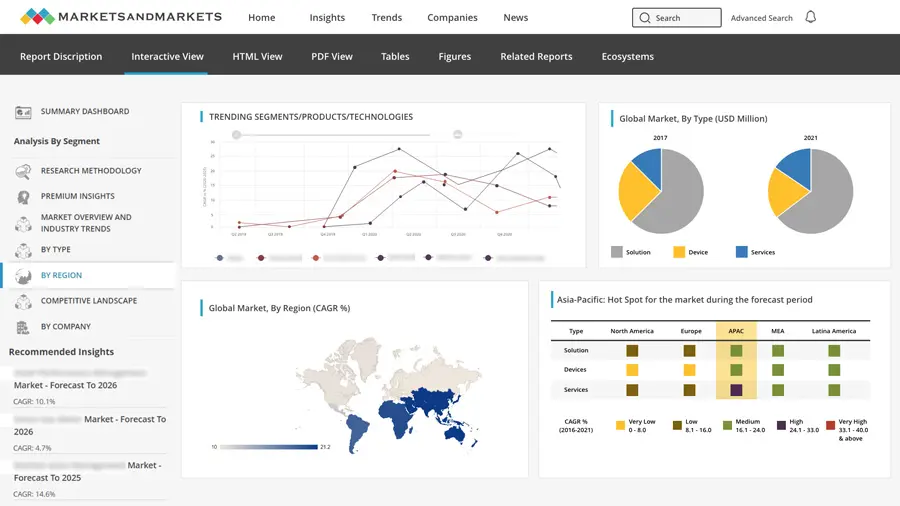
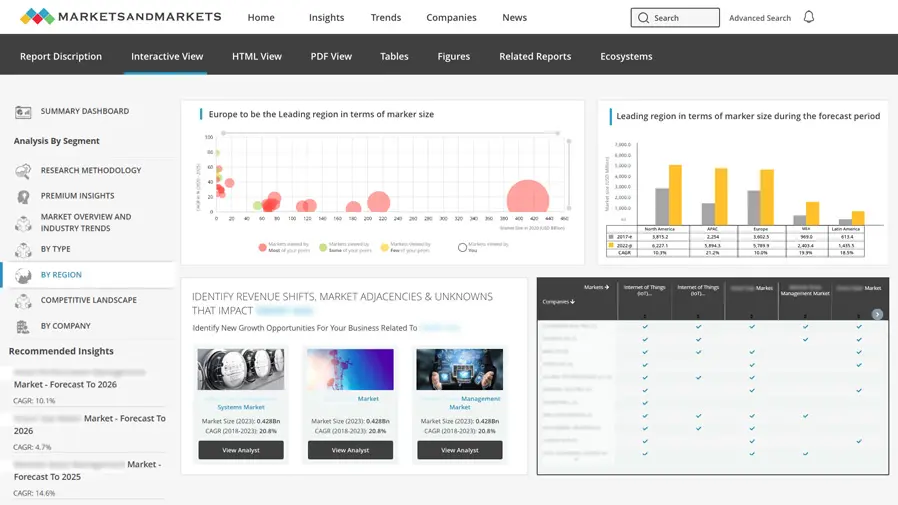
Kyle
Mar, 2022
Can you share the detailed information on technological advancements in the Infection Control Market?.
Ethan
Mar, 2022
In what way COVID19 is Impacting the global growth of the Infection Control Market?.
Walter
Mar, 2022
Can you enlighten us about the key players operating in the global Infection Control Market?.